AI: A disruption in science, technology, philosophy, art and society.
Posted by Jair Sánchez, on 10 September 2024
Artificial intelligence has emerged as a beacon of innovation, offering not only groundbreaking solutions but also raising profound questions that remind us of the ever-present challenge of understanding ourselves and what it means to be human. Through intricate mathematical models, we now possess tools to approach and reflect on some of the most profound inquiries of existence: consciousness, free will, ethics, morality, and reason. These timeless questions, once the realm of history’s most esteemed philosophers, resurface today, inviting reflection on the core elements of our nature. They compel us to strengthen, appreciate, and safeguard the natural intelligence inherent in all of us, ensuring it is neither forgotten nor overshadowed.
Like any tool, the impact of artificial intelligence, whether for good or ill, rests in the intentions and skill of those who wield it. Just as fire, when tamed, shaped the course of civilization, AI, if harnessed wisely, can offer untold benefits. While fears abound that these technologies might one day replace us in many professions, it is within our power as a society to prevent such outcomes. With careful guidance from experts, we can foster a partnership between human intellect and artificial systems, creating a symbiotic approach to problem-solving that advances the common good.
Consider the medical field: the advent of antibiotics and sophisticated diagnostic tools enhanced the role of physicians rather than replacing them. Similarly, AI should not be seen as a replacement for human expertise but as an augmentation of it. To do otherwise would rob us of the passion, creativity, and ingenuity that only humans bring to their work. This is especially true in the arts, where the creative process is deeply tied to personal expression, something a machine can never replicate. While artificial intelligence operates within the bounds of rules and algorithms, the human artist is bound only by the limits of their imagination. In this light, AI, like the internet before it, should be viewed as a transformative force reshaping how we learn, communicate, and experience the world.
We have crafted artificial intelligence in our image, and in doing so, we confront a philosophical question: What does this mirror reveal?
Perhaps it offers a glimpse of our own innate capacities, expressed through the elegant precision of probabilistic models and statistical phenomena, seamlessly executed by a machine.
AI has infiltrated every corner of society through technological tools that now perform tasks once requiring significant time and effort, or tasks that were once considered unimaginable. From generating art and music to editing photos and composing text, these systems accomplish with ease what once seemed impossible. With a simple prompt, we can now conjure images, compose music, or generate written content, a development that has transformed how people engage with creativity, technology, and work.
This, in turn, has led to a spectrum of reactions: excitement, concern, or wonder, depending on how and in what context individuals encounter these tools. In the realm of science, AI has proven invaluable, fostering interdisciplinary collaboration and enabling researchers to uncover insights and correlations that would have been previously inaccessible. In fields like biotechnology and medicine, where vast amounts of data are analyzed to decipher complex patterns, AI has become an essential ally, driving progress and reshaping paradigms across numerous disciplines.
In conclusion, the rise of artificial intelligence introduces a new era, one that demands thoughtful reflection and responsibility. As with previous technological revolutions, AI presents the risk of misinformation and deception, as it becomes increasingly difficult to discern truth from fabricated narratives. However, this is not unprecedented; the same concerns arose with the advent of the internet, television, and radio.
At this moment, we are called to sharpen our critical thinking and seek out truth in a world inundated with information. We must not surrender our intelligence to machines, but we also cannot ignore the possibilities they offer. The simple yet profound act of human thought, honed over millennia, remains irreplaceable. While AI may assist and augment our capabilities, the essence of human cognition, creativity, and reflection must remain at the forefront. It is, after all, the correct and mindful use of new tools that has always propelled humanity forward.
I would like to conclude with an illustration I created, which seeks to illuminate the essence of human creativity and its intricate connection to the complex processes of cognition. This piece aims to capture the dynamic interplay between imagination and intellect, offering a reflection on how creativity emerges from the depths of thought and understanding.



 (6 votes, average: 1.00 out of 1)
(6 votes, average: 1.00 out of 1)
It’s becoming clear that with all the brain and consciousness theories out there, the proof will be in the pudding. By this I mean, can any particular theory be used to create a human adult level conscious machine. My bet is on the late Gerald Edelman’s Extended Theory of Neuronal Group Selection. The lead group in robotics based on this theory is the Neurorobotics Lab at UC at Irvine. Dr. Edelman distinguished between primary consciousness, which came first in evolution, and that humans share with other conscious animals, and higher order consciousness, which came to only humans with the acquisition of language. A machine with only primary consciousness will probably have to come first.
What I find special about the TNGS is the Darwin series of automata created at the Neurosciences Institute by Dr. Edelman and his colleagues in the 1990’s and 2000’s. These machines perform in the real world, not in a restricted simulated world, and display convincing physical behavior indicative of higher psychological functions necessary for consciousness, such as perceptual categorization, memory, and learning. They are based on realistic models of the parts of the biological brain that the theory claims subserve these functions. The extended TNGS allows for the emergence of consciousness based only on further evolutionary development of the brain areas responsible for these functions, in a parsimonious way. No other research I’ve encountered is anywhere near as convincing.
I post because on almost every video and article about the brain and consciousness that I encounter, the attitude seems to be that we still know next to nothing about how the brain and consciousness work; that there’s lots of data but no unifying theory. I believe the extended TNGS is that theory. My motivation is to keep that theory in front of the public. And obviously, I consider it the route to a truly conscious machine, primary and higher-order.
My advice to people who want to create a conscious machine is to seriously ground themselves in the extended TNGS and the Darwin automata first, and proceed from there, by applying to Jeff Krichmar’s lab at UC Irvine, possibly. Dr. Edelman’s roadmap to a conscious machine is at https://arxiv.org/abs/2105.10461